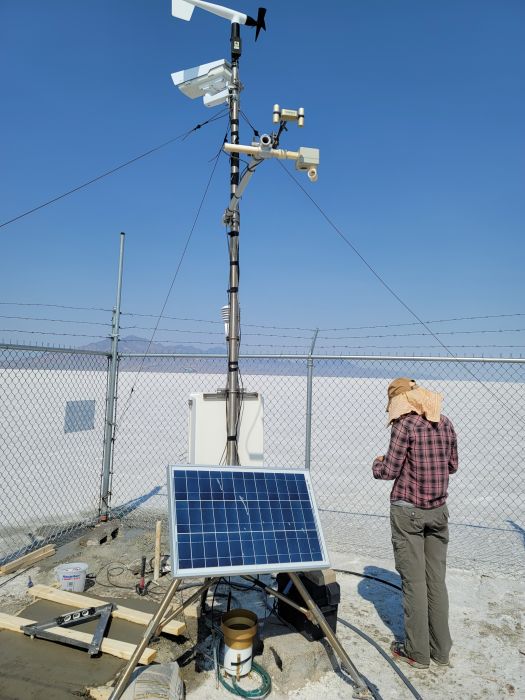



ユタ州地質調査所は、ユタ州水利権局の支援を受けて、ユタ州全域に蒸発散量を測定するための渦相関観測所のネットワークを構築しました。これらの観測所は、陸地からの水の蒸発と植物による水の蒸散を合わせた量を測定します。消費的使用、つまり植物によって吸収され蒸散される水は、耕作地を含む植生地帯の蒸発散に大きく貢献します。
ユタ州の水管理者が農業活動によって節約または使用される水を正確に判断するには、同州における水使用の地上測定の改善が不可欠です。ユタ フラックス ネットワーク (UFN) の目的は 2 つあります。1 つは、渦共分散法を使用してフィールドでの蒸発散量を測定し、そのデータを衛星で収集した測定値と比較することです。この目的のため、UFN はこれまでに 4 つの渦共分散ステーションを設置しており、今後もさらに設置する予定です。
これらのステーションは、研究グレードの計測機器のコア セットから構築されています。各ステーションには次のものが含まれます。
- データロガー(CR1000XまたはCR6)
- 統合型音波風速計付きガス分析装置 (IRGASON)
- 温度および相対湿度プローブ(EE181-L)
- 4ウェイネットラジオメーター(NR01-L)
- 土壌熱流計(HFP01-L)
- 土壌温度センサー(TCAV-L)
- 土壌水分センサー(CS655およびSoilVue™10)
- 機械式風速計と風向計
- 光合成有効放射線(PAR)センサー
- 太陽光発電システム
各観測所は、観測所の風上地域に出入りする水蒸気、CO2、エネルギーの動きを正確に測定します。純放射計と土壌センサーは、エネルギーバランスと土壌熱流束を研究するために使用されます。これらの機器はすべて非常に正確で、その多くは極めて高い速度で測定値を取得できます。
ユタ州サンファン郡の Nature Conservancy のダグアウト ランチを含む、いくつかの新しいステーションがまもなく設置されます。新しいステーションは、Campbell Scientific のアプリケーション エンジニアと共同で慎重に設計され、その後、Campbell Scientific の製造およびクライアント サービス チームによって細心の注意を払って構築およびパッケージ化されました。ステーションは事前に配線され、プログラムされているため、UFN はネットワークの展開を迅速に行うことができます。
UFN は現在、AmeriFlux、FLUXNET (国際気候データ ネットワーク)、および MesoWest にデータを提供しています。UFN のデータは、ウォーター バンクなどの長期的な水保全および管理戦略にも役立ちます。プライス ウォーター バンク パイロット プロジェクト (ユタ州プライス近郊で保全された農業用水を河川水に変換) とコロラド川協定 (コロラド川上流域での消費量を測定) の管理は、どちらも UFN のデータを使用しています。UFN から収集された測定値は、水文学モデルや気候モデルにも使用できます。これらのステーションは、二酸化炭素 (CO 2 )、水 (H 2 O)、利用可能なエネルギーなど、重要な大気成分を測定しているからです。